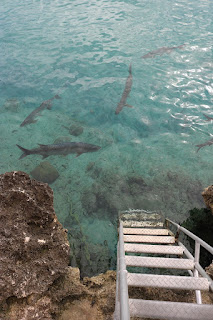Fasten your seat belts. We are in for a bit of a bumpy ride. For starters, we are going to unapologetically
spell center as “centre” since we are presently in an English Territory. Secondly, we are going to talk a bit about
killing and eating sea turtles.
The history of the Cayman Islands is very much
a history about sea turtles as well. Christopher
Columbus, when he found the two smaller islands in 1503, originally named the
islands “Las Tortugas” (Tortuga being the Spanish word for turtle). The islands and surrounding reefs supported extraordinary
populations of sea turtles.
Word of the islands quickly made way round the
seafaring world. The islands soon became
a regular stop-over for sailing ships seeking provisions.
By provisions, I mean (mostly) turtle
meat.
Turtles were something of a perfect food item
on a long voyage. They were easy to
catch, and they were also easy to keep alive onboard ships as a source of fresh
meat. The turtles could even survive
long periods of time helplessly stranded on their backs.
By the 1800s, however, most of the Cayman turtle
population was depleted. The “turtling
industry” that had developed around the islands was forced to seek turtles in
other locations.
Cayman Turtle Centre was established in 1968
by a group of private investors. The
intent of the centre was that of raising green sea turtles for “commercial use”
(read “eating them” here).
I cannot find myself being at all judgmental
about this. The whole idea was to assure
that wild populations would not be further depleted by those still seeking sea
turtles for dinner. Furthermore, a great
deal of valuable research has been a result of the centre’s work. Today, in fact, the center is working with a second
generation of breading turtles produced in domestication.
Regulations fashioned by the U. S. and other
countries to protect sea turtles soon blocked commercial turtle sales and the centre’s
commercial turtle operation went bankrupt in 1975. At that time, some 100,000 turtles were being
fed at the centre.
Following the collapse of the original company
operating the turtle centre, both private investors and the Cayman Island
Government have been involved in keeping the centre open. The centre weathered Hurricane Michelle in 2001
and Hurricane Ivan in 2004 at great cost.
A local we talked with told us that Hurricane Ivan was such that it even
destroyed the coral reef just offshore from her home.
Today, Cayman Turtle Centre still serves the
dual purpose of raising turtles for meat and for release into the ocean. To date, some 31 thousand partially-grown
turtles have been safely released into the ocean by the centre.
While the centre has been criticized for,
among other issues, holding captive in small spaces, animals that might migrate
for hundreds or thousands of miles in the wild, a lot of good has come from the centre’s long-term operation.
Yesterday, the group of us visited the
centre. Though raised in the high,
mountainous West of the United States, we all feel a mighty affection for the
sea turtles.
For us, eating one is out of the question.
A pair of immature
turtles
Mature green sea turtle
Turtles and Montanans
Sunset at our private beach
—Mitchell Hegman























